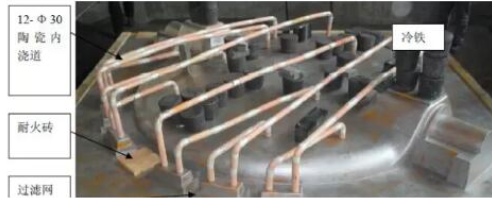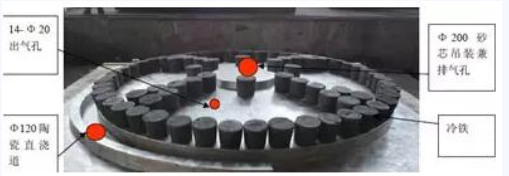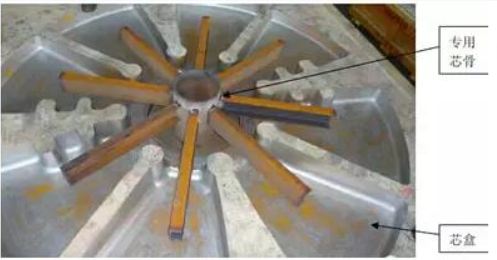1. Structural analysis
(1) This butterfly valve has a circular cake-shaped structure, the inner cavity is connected and supported by 8 reinforcing ribs, the top Φ620 hole communicates with the inner cavity, and the rest of the valve is closed, the sand core is difficult to fix and easy to deform. Both the exhaust and the cleaning of the inner cavity bring great difficulties, as shown in Figure 1.
The wall thickness of the castings varies greatly, the maximum wall thickness reaches 380mm, and the minimum wall thickness is only 36mm. When the casting is solidified, the temperature difference is large, and the uneven shrinkage can easily produce shrinkage cavities and shrinkage porosity defects, which will cause water seepage in the hydraulic test.
2. Process design:
(1) The parting surface is shown in Figure 1. Put the end with holes on the upper box, make a whole sand core in the middle cavity, and lengthen the core head appropriately to facilitate the fastening of the sand core and the movement of the sand core when the box is turned over. Stable, the length of the cantilever core head of the two blind holes on the side is longer than the length of the hole, so that the center of gravity of the entire sand core is biased to the side of the core head to ensure that the sand core is fixed and stable.
A semi-closed pouring system is adopted, ∑F inside: ∑F horizontal: ∑F straight=1:1.5:1.3, the sprue uses a ceramic tube with an inner diameter of Φ120, and two pieces of 200×100×40mm refractory bricks are placed at the bottom to prevent the molten iron from directly For the impact sand mold, a 150×150×40 foam ceramic filter is installed at the bottom of the runner, and 12 ceramic tubes with an inner diameter of Φ30 are used for the inner runner to connect evenly to the bottom of the casting through the water collection tank at the bottom of the filter to form a bottom pouring pouring scheme, as shown in Figure 2 Essence
(3) Place 14 ∮20 cavity air holes in the upper mold, place a Φ200 sand core vent hole in the middle of the core head, place cold iron in the thick and large parts to ensure balanced solidification of the casting, and use the graphitization expansion principle to cancel The feeding riser is used to improve the process yield. The size of the sand box is 3600×3600×1000/600mm, and it is welded with 25mm thick steel plate to ensure sufficient strength and rigidity, as shown in Figure 3.
3. Process control
(1) Modeling: Before modeling, use a Φ50×50mm standard sample to test the compressive strength of the resin sand ≥ 3.5MPa, and tighten the cold iron and the runner to ensure that the sand mold has sufficient strength to offset the graphite produced when the molten iron solidifies Chemical expansion, and prevent the molten iron from impacting the runner part for a long time to cause sand washing.
Core making: The sand core is divided into 8 equal parts by 8 reinforcing ribs, which are connected through the middle cavity. There are no other support and exhaust parts except the middle core head. If the sand core cannot be fixed and Exhaust, sand core displacement and air holes will appear after pouring. Because the overall area of the sand core is large, it is divided into eight parts. It must have sufficient strength and rigidity to ensure that the sand core will not be damaged after mold release, and will not be damaged after pouring. Deformation occurs, so as to ensure the uniform wall thickness of the casting. For this reason, we specially made a special core bone, and tied it on the core bone with a ventilation rope to draw the exhaust gas from the core head to ensure the compactness of the sand mold when making the core. As shown in Figure 4.
(4) Closing box: Considering that it is difficult to clean the sand in the inner cavity of the butterfly valve, the entire sand core is painted with two layers of paint, the first layer is brushed with alcohol-based zirconium paint (Baume degree 45-55), and the first layer is painted and burned. After drying, paint the second layer with alcohol-based magnesium paint (Baume degree 35-45) to prevent the casting from sticking to sand and sintering, which cannot be cleaned. The core head part is hung on the Φ200 steel pipe of the main structure of the core bone with three M25 screws, fixed and locked with the upper mold sand box with screw caps and checked whether the wall thickness of each part is uniform.
4. Melting and pouring process
(1) Use Benxi low-P, S, Ti high-quality Q14/16# pig iron, and add it at a ratio of 40%~60%; trace elements such as P, S, Ti, Cr, Pb, etc. are strictly controlled in scrap steel, and no rust and oil are allowed , the addition ratio is 25%~40%; the returned charge must be cleaned by shot blasting before use to ensure the cleanliness of the charge.
(2) Main component control after furnace: C: 3.5-3.65%, Si: 2.2%-2.45%, Mn: 0.25%-0.35%, P≤0.05%, S: ≤0.01%, Mg (residual): 0.035% ~0.05%, under the premise of ensuring spheroidization, the lower limit of Mg (residual) should be taken as much as possible.
(3) Spheroidization inoculation treatment: low-magnesium and low-rare-earth spheroidizers are used, and the addition ratio is 1.0%~1.2%. Conventional flushing method spheroidization treatment, 0.15% of one-time inoculation is covered on the nodulizer at the bottom of the package, and the spheroidization is completed. The slag is then subcontracted for secondary inoculation of 0.35%, and flow inoculation of 0.15% is carried out during pouring.
(5) Low temperature fast pouring process is adopted, the pouring temperature is 1320°C~1340°C, and the pouring time is 70~80s. The molten iron cannot be interrupted during pouring, and the sprue cup is always full to prevent gas and inclusions from being involved in the mold through the runner. cavity.
5. Casting test results
(1) Test the tensile strength of the cast test block: 485MPa, elongation: 15%, Brinell hardness HB187.
(2) The spheroidization rate is 95%, the size of graphite is grade 6, and the pearlite is 35%. The metallographic structure is shown in Figure 5.
(3) No recordable defects were found in the UT and MT secondary flaw detection of important parts.
(4) The appearance is flat and smooth (see Figure 6), without casting defects such as sand inclusions, slag inclusions, cold shuts, etc., the wall thickness is uniform, and the dimensions meet the requirements of the drawings.
(6) 20kg/cm2 hydraulic pressure test after processing did not show any leakage
6. Conclusion
According to the structural characteristics of this butterfly valve, the problem of unstable and easy deformation of the large sand core in the middle and difficult sand cleaning is solved by emphasizing on the design of the process plan, the production and fixing of the sand core and the use of zirconium-based coatings. The setting of vent holes avoids the possibility of pores in castings. From the furnace charge control and runner system, foam ceramic filter screen and ceramic ingate technology are used to ensure the purity of molten iron. After multiple inoculation treatments, the metallographic structure of castings and various The comprehensive performance has reached the standard requirements of customers
From Tianjin Tanggu Water-seal valve Co.,ltd. Butterfly valve, gate valve, Y-strainer, wafer dual plate check valve manufacture.
Post time: Apr-29-2023






